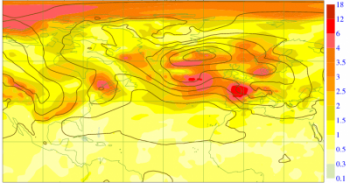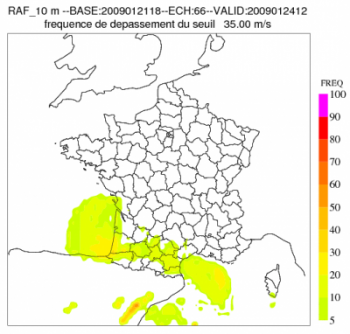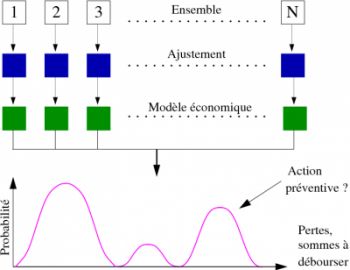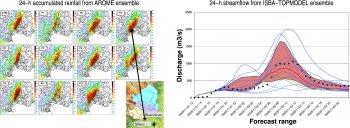Predictability
Predictability is about understanding the sources of forecast errors, and developing real time tools such as ensemble forecasting, to help quantify the forecast uncertainty. Observation targeting is the development of techniques that optimize the observing network in real time, in order to maximize the usefulness of forecasts. Both use similar techniques for assessing the propagation of errors through the NWP data assimilation and forecasting system.
Hydrometeorological ensemble forecasting of heavy precipitation events in the Mediterranean region
Researchers contributing to this topic : François Bouttier, Olivier Nuissier and Laure Raynaud CNRM-GAME/GMAP/RECYF
The western Mediterranean area is frequently affected by high-impact weather events that produce disastrous flash-flood events responsible for many human casualties and heavy damages in the past decades. The ability to predict such dramatic events remains weak because of the contribution of very fine-scale processes and their non-linear interactions with the larger scale processes. Whereas large-scale meteorological environment propitious to heavy precipitation is well known, progress has to be made on the comprehension and modelling of the mechanisms and their interaction that govern the precise location of the anchoring region of the precipitating system as well as of those that produce in some cases uncommon amount of precipitation. The forecast of the exact location of maximum precipitation is really crucial as the hydrological response of the typical small and steep Mediterranean watersheds is very sensitive to that location.
To make significant progresses on the predictability of such events, one should tackle the whole range of key process scales in order to sample the different uncertainty sources at various scales that govern precipitating systems.
The aim of this research topic is precisely to design and evaluate new integrated and nested approaches to characterise those uncertainties and their propagation from the meteorological forecast to the hydrological response. A hydrometeorological ensemble approach is designed and results are presented here for a quasi-stationary convective system case with high rainfall amounts.
Taking weather forecast uncertainty at both synoptic and fine-scale requires a nested approach: an AROME (2.5-km horizontal resolution) ensemble is coupled to eleven members provided by PEARP, the global ensemble forecasting system of Météo-France. The use of a specific mesoscale data initialization enables the determination of accurate high-resolution initial conditions. Finally, the resulting AROME forecasts are used to drive the hydrological ISBA-TOPMODEL system to characterise the uncertainty on discharge forecast.
The AROME rainfall fields show a significant variability of the simulated precipitation around the observations both in intensity and location. Concerning the hydrological forecasts, most of them underestimated the discharge but this ensemble approach indicated a possible flood of Gardons river at Boucoiran unlike the simulation using the deterministic AROME forecast.
Ensemble forecasting is a numerical prediction method that aims to understand and quantify the uncertainty inherent in any meteorological forecast.
Ensemble forecasting does not seek to provide a single deterministic forecast, but a set of scenarios whose variations are representative of the uncertainty associated with forecasting the state of the atmospheric flow.
This consists in making several simulations from different initial states. These initial states are created so as to best sample the uncertainty in the knowledge of the atmospheric state. Furthermore, for each simulation, the model used can be slightly modified to take into account the uncertainties in the representation of the laws of evolution of the atmosphere.
Taking into account the numerical cost of the forecasts, an ensemble forecast is generally made of a few tens of simulations.
Use of ensemble forecasts
Researchers contributing to this topic : Laurent Descamps, Pierrick Cébron, Carole Labadie and Olivier Pannekoucke CNRM-GAME/GMAP/RECYF
1. For the forecaster
Dispersion and uncertainty measurement
The discrepancies between the various scenarios forecast by the ensemble system, represented in the form of a dispersion map, give quantitative information about the areas where the uncertainty is the largest. For a given forecast time, the larger the dispersion, the higher the uncertainty about the future state of the atmosphere.

(figure1:)
PEARP dispersion (Prévision d’Ensemble ARPège = ARPEGE ensemble forecast) for atmospheric pressure in hectopascals. 36-hour forecast from 22 January 2009. Coloured areas represent discrepancies between the various scenarios forecast by different members of the ensemble. The more colours are going towards red, the higher the dispersion, and therefore the higher the uncertainty in the forecast state. It should be noted that this uncertainty varies a lot from one geographical area to another.
Information in probabilistic form:
The idea is to use the forecast ensemble as representing a sample of a probability distribution. The forecast ensemble can then provide probabilistic information on the occurrence of an event: the forecaster can visualise maps of the probability of exceeding a threshold, or the value of parameters (accumulated rain, wind strength, etc.) reached by a given percentage of members of the ensemble.

(figure2:)
Forecast starting on 21 January 2009, for 24 January 2009. Probability of gust strength exceeding 35m/s (126km/h). Coloured areas describe the probability of a strong storm crossing south-western France.
Communicating forecast uncertainty in the mass media:
At present, the forecaster uses ensemble forecasting mainly for times more than 4 days ahead (in general, uncertainty grows with forecast time). The forecaster’s work is to summarise and translate the information contained in ensemble forecasts in the form of a confidence index.
For shorter forecast times, the forecaster can adjust the “general” weather forecast to explain that forecasts contain a part of uncertainty.
2. For “weather-sensitive” economic sectors
Ensemble forecasting provides a quantitative and objective measurement of the uncertainty. It enables in a natural way acceptable risk management in terms of cost/loss ratio. The user can better decide, using probabilistic information, the actions that may be undertaken in order to reduce losses due to the effects of a weather event on economic activity.
The potential economic value of an ensemble forecast is higher than that of a deterministic forecast.

A partir d’un ajustement et d’un modèle économique liant le domaine d’activité aux prévisions d’ensemble, on obtient une prévision probabiliste des risques liés à la situation météorologique. Ainsi, en fonction de la probabilité d’occurrence d’un évènement entraînant un niveau de pertes jugé inacceptable, il est possible de décider de la mise en place de mesures préventives.
(figure3:)
Use of ensemble forecasts in the socio-economic area. Using an adjustment and an economic model relating the area of activity to ensemble forecasts, a probabilistic forecast of the risks due to the weather situation is obtained. Thus, depending on the probability of occurrence of an event causing a level of losses considered unacceptable, it is possible to decide to set up preventive measures.




